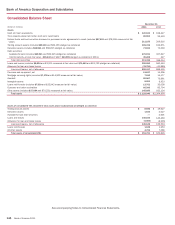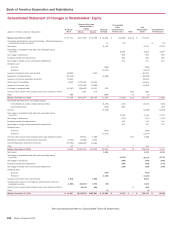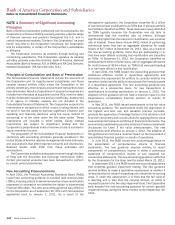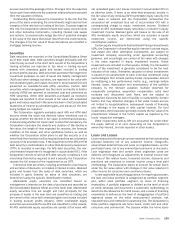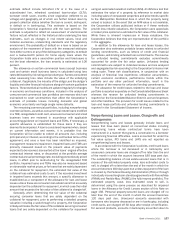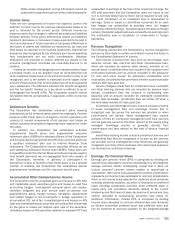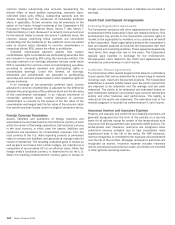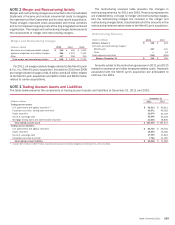Bank of America 2011 Annual Report Download - page 160
Download and view the complete annual report
Please find page 160 of the 2011 Bank of America annual report below. You can navigate through the pages in the report by either clicking on the pages listed below, or by using the keyword search tool below to find specific information within the annual report.158 Bank of America 2011
the collateral value, less costs to sell, by the end of the month in
which the account becomes 60 days past due. Consumer credit
card loans, consumer loans secured by personal property and
unsecured consumer loans are not placed on nonaccrual status
prior to charge-off and therefore are not reported as nonperforming
loans. Real estate-secured loans are generally placed on
nonaccrual status and classified as nonperforming at 90 days past
due. However, consumer loans secured by real estate in the fully-
insured portfolio are not placed on nonaccrual status, and
therefore, are not reported as nonperforming loans. Accrued
interest receivable is reversed when a consumer loan is placed
on nonaccrual status. Interest collections on nonaccruing
consumer loans for which the ultimate collectability of principal is
uncertain are applied as principal reductions; otherwise, such
collections are credited to interest income when received. These
loans may be restored to accrual status when all principal and
interest is current and full repayment of the remaining contractual
principal and interest is expected, or when the loan otherwise
becomes well-secured and is in the process of collection.
Consumer loans whose contractual terms have been modified
in a TDR and are current at the time of restructuring remain on
accrual status if there is demonstrated performance prior to the
restructuring and payment in full under the restructured terms is
expected. Otherwise, the loans are placed on nonaccrual status
and reported as nonperforming until there is sustained repayment
performance for a reasonable period, generally six months.
Consumer TDRs that are on accrual status are reported as
performing TDRs through the end of the calendar year in which the
restructuring occurred or the year in which the loans are returned
to accrual status. In addition, if accruing consumer TDRs bear less
than a market rate of interest at the time of modification, they are
reported as performing TDRs throughout their remaining lives
unless and until they cease to perform in accordance with their
modified contractual terms, at which time they would be placed
on nonaccrual status and reported as nonperforming TDRs.
Commercial loans and leases, excluding business card loans,
that are past due 90 days or more as to principal or interest, or
where reasonable doubt exists as to timely collection, including
loans that are individually identified as being impaired, are
generally placed on nonaccrual status and classified as
nonperforming unless well-secured and in the process of
collection. Commercial loans and leases whose contractual terms
have been modified in a TDR are typically placed on nonaccrual
status and reported as nonperforming until the loans have
performed for an adequate period of time under the restructured
agreement, generally six months. If the borrower had
demonstrated performance under the previous terms and the
underwriting process shows the capacity to continue to perform
under the modified terms, the loans and leases may remain on
accrual status. Accruing commercial TDRs are reported as
performing TDRs through the end of the calendar year in which the
loans are returned to accrual status. In addition, if accruing
commercial TDRs bear less than a market rate of interest at the
time of modification, they are reported as performing TDRs
throughout their remaining lives unless and until they cease to
perform in accordance with their modified contractual terms, at
which time they would be placed on nonaccrual status and reported
as nonperforming TDRs.
Accrued interest receivable is reversed when a commercial loan
is placed on nonaccrual status. Interest collections on nonaccruing
commercial loans and leases for which the ultimate collectability
of principal is uncertain are applied as principal reductions;
otherwise, such collections are credited to income when received.
Commercial loans and leases may be restored to accrual status
when all principal and interest is current and full repayment of the
remaining contractual principal and interest is expected, or when
the loan otherwise becomes well-secured and is in the process of
collection. Business card loans are charged off no later than the
end of the month in which the account becomes 180 days past
due or 60 days after receipt of notification of death or bankruptcy
filing. These loans are not placed on nonaccrual status prior to
charge-off and therefore are not reported as nonperforming loans.
Other commercial loans are generally charged off when all or a
portion of the principal amount is determined to be uncollectible.
The entire balance of a consumer and commercial loan is
contractually delinquent if the minimum payment is not received
by the specified due date on the customer’s billing statement.
Interest and fees continue to accrue on past due loans until the
date the loan goes into nonaccrual status, if applicable.
PCI loans are recorded at fair value at the acquisition date.
Although the PCI loans may be contractually delinquent, the
Corporation does not classify these loans as nonperforming as
the loans were written down to fair value at the acquisition date
and the accretable yield is recognized in interest income over the
remaining life of the loan. In addition, reported net charge-offs
exclude write-downs on PCI loan pools as the fair value already
considers the estimated credit losses.
Loans Held-for-sale
Loans that are intended to be sold in the foreseeable future,
including residential mortgages, loan syndications, and to a lesser
degree, commercial real estate, consumer finance and other loans,
are reported as LHFS and are carried at the lower of aggregate
cost or fair value. The Corporation accounts for certain LHFS,
including first mortgage LHFS, under the fair value option.
Mortgage loan origination costs related to LHFS that the
Corporation accounts for under the fair value option are recognized
in noninterest expense when incurred. Mortgage loan origination
costs for LHFS carried at the lower of cost or fair value are
capitalized as part of the carrying amount of the loans and
recognized as a reduction of mortgage banking income upon the
sale of such loans. LHFS that are on nonaccrual status and are
reported as nonperforming, as defined in the policy above, are
reported separately from nonperforming loans and leases.
Premises and Equipment
Premises and equipment are carried at cost less accumulated
depreciation and amortization. Depreciation and amortization are
recognized using the straight-line method over the estimated
useful lives of the assets. Estimated lives range up to 40 years
for buildings, up to 12 years for furniture and equipment, and the
shorter of lease term or estimated useful life for leasehold
improvements.
The Corporation capitalizes the costs associated with certain
computer hardware, software and internally developed software,
and amortizes the costs over the expected useful life. Direct project
costs of internally developed software are capitalized when it is
probable that the project will be completed and the software will
be used for its intended function.


